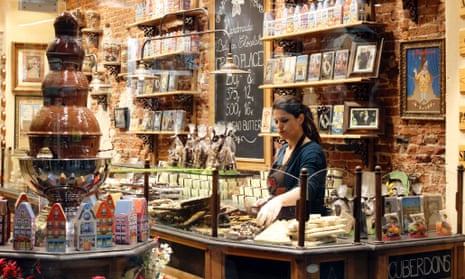Take a walk down Saffron Avenue in the Docklands of east London, turn the corner on to Nutmeg Lane or Rosemary Drive, and you’ll be in for a disappointment. Where once you might have smelt the exotic aromas of spicy cargo, now stands the hulking grey shed of a telephone exchange and a lingering whiff of disinfectant.
“Our cities are losing their smells,” says Victoria Henshaw, town planner turned odour advocate at the University of Sheffield, who has made it her mission to champion the importance of aroma in urban spaces. “Smells are seen as something negative, to be banished at all costs, but we’ve now become deodorised to the extent that people are developing an increasing number of allergies and environmental sensitivities. It’s much healthier to be exposed to strong smells.”
We meet in central London, where she is conducting a “smell walk” as part of the Royal Academy’s Sensing Spaces exhibition, taking visitors on a sensory stroll through the West End. On Piccadilly, we pass through a sickly sweet cloud emanating from a chocolate shop, followed by a spicy whiff from a noodle bar. We poke our noses into a newsagent, for that familiar cocktail of chewing gum and newsprint, and into an antiquarian bookseller for the comforting musty guff of old paper and leather binding.
We emerge on to Regent Street and hit a wall of old ladies’ perfume, continental cigarettes, and the unmistakable floral miasma drifting across the road from a branch of Lush. “When he’s visiting regional branches, the UK manager of Lush says he gets off the train and just follows his nose,” says Henshaw – the test presumably being that if he can’t detect the stench of bath bombs, then they’re not trying hard enough.
Regent Street, it turns out, is something of a scent gauntlet, each shop competing to lure in customers with its own distinct aroma. Penhaligon’s perfumery goes one step beyond, with its own diffuser spurting out clouds of the current season’s fragrance into the street.
“It works a treat,” says the shop assistant. “We always sell out of whichever perfume is in the diffuser that week.” It is currently Elixir, which smells a bit like a church, soon to be replaced with a springtime fragrance, “with notes of citrus and Earl Grey”. Around the corner, the topless male models at Abercrombie & Fitch radiate the “rugged, classic, cool” smell of their Fierce cologne, which is also regularly sprayed on to the clothes and around the shop floor. So, far from sterilising our cities, aren’t we filling them with ever more fragrances than before?

“What we’re seeing is clone smells, like clone towns,” says Henshaw. “The same businesses bring the same smells. But town centre management is still about deodorisation – particularly in the States, where there are even bans on wearing perfume in public places, due to increasing sensitivities.”
She recounts the story of an advert for milk at a bus stop in San Francisco, infused with the smell of cookies, which was removed within 24 hours after a fierce local campaign. “We’re still so suspicious of our senses being manipulated, particularly smell, as it’s something we still understand the least.”
Japan, she says, has one of the most advanced attitudes towards the olfactory sense and its relationship to place, going as far as declaring “One Hundred Sites of Good Fragrance” across the country. From the sea mist of Kushiro to the Nanbu rice cracker of Morioka, not to mention the distinct smell of glue that hangs in the air around the doll craftsmen’s homes in Koriyama, all now have protected status.
Back in the Royal Academy cafe, where the smell of coffee mingles with toilet cleaner, Henshaw delves into her bag. “I wasn’t sure what we would find on our walk, so I brought a bag of smells with me.”
She pulls out a handful of small vials that contain the scents of hospitals and breweries, dinosaur poo and a bomb blast – along with a can of “Glasgow,” which unleashes a heady pong of shipyards and smoke. Then she removes something that looks like a cross between a hairdryer and a ray gun, holds it up to her nose and spins a dial. It is a Nasal Ranger, also known as a field olfactometer, the device environmental health officers use to measure and quantify odour strength, by diluting air quality in relation to human perception levels.
“If a smell is still perceptible when it’s diluted seven times, then it’s deemed to be too strong and action can be taken,” says Henshaw. I crank it up and take a sniff. Luckily for the Royal Academy, their cocktail of coffee and bleach fades away. Only a faint hint of Glasgow remains.

Comments (…)
Sign in or create your Guardian account to join the discussion